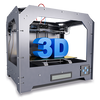
Exploring Inductors: Uses and Limitations
If resistors are the brakes and capacitors are the batteries of electronics, then inductors are the magnetic muscles. They store energy in magnetic fields, oppose sudden changes in current, and play a starring role in power electronics, audio systems, and high-frequency circuits. But despite their versatility, inductors remain one of the least understood components by beginners.
In this article, we’ll demystify what inductors are, how they’re used, and where their limitations show up so you know when to reach for one (and when not to).
What Is an Inductor?
An inductor is a passive electrical component that resists changes in current by storing energy in a magnetic field. It’s typically made of a coil of wire, and when current flows through it, that coil generates magnetism.
The amount of inductance is measured in henries (H) but most practical inductors for electronics are rated in microhenries (μH) or millihenries (mH).
👉 Shop Assorted Inductors at Tomson Electronics
How Does an Inductor Work?
The magic of inductors lies in Faraday’s Law of Induction. When the current flowing through an inductor changes, it creates a changing magnetic field. This magnetic field induces a voltage opposite in direction to the change a property called self-inductance.
In simpler terms:
-
Inductors allow DC to pass steadily
-
But they resist sudden changes in current, especially in AC or pulsed circuits
That’s what makes them useful in power supplies, filters, energy storage, and high-frequency circuits.
Types of Inductors and Their Applications
Let’s explore the most common inductor types and where you might use them.
1. Wire-Wound Inductors
These are traditional inductors made by winding wire around a core air, ferrite, or iron.
Applications:
-
Power filters
-
Buck/boost converters
-
Low-frequency chokes
2. Ferrite Beads
These are small inductors used for suppressing high-frequency noise in digital circuits and power lines.
Applications:
-
EMI filtering in USB, I/O lines
-
Noise suppression in microcontrollers
-
Power supply smoothing
3. Toroidal Inductors
Toroids are donut-shaped inductors with low electromagnetic interference (EMI) and efficient magnetic paths.
Applications:
-
DC-DC converters
-
High-efficiency power supplies
-
Audio filters
4. SMD Inductors
These are surface-mount components for compact PCBs.
Applications:
-
Smartphones and IoT modules
-
Wearable electronics
-
High-density embedded systems
Real-World Uses of Inductors
Inductors appear in far more places than you might expect. Here are some practical roles they play:
1. Power Supply Filtering
In AC to DC conversion, inductors smooth out voltage by filtering out high-frequency ripple. Combined with capacitors, they form LC filters that stabilize the output voltage.
Example: 220μH inductor in a 12V buck converter to reduce output ripple.
2. Buck/Boost Converters
Inductors act as temporary energy stores during switching cycles in voltage regulators. Their ability to ramp current up/down smoothly makes them ideal for efficient conversion.
Example: ESP32 modules use a buck converter with a 47μH inductor for 3.3V regulation.
3. RF Signal Tuning
In radio-frequency circuits, inductors combine with capacitors to form tuned LC circuits that pass or block specific frequencies.
Example: An FM radio uses inductors to tune and isolate the desired frequency band.
4. EMI and Noise Suppression
Inductors block high-frequency signals and let low-frequency signals pass. That makes them ideal for blocking electromagnetic interference (EMI) from power lines or noisy ICs.
Example: Ferrite beads used on USB cables to prevent data loss from EMI.
5. Audio Crossovers
In speaker systems, inductors help separate low and high frequencies, ensuring that each driver only gets the audio signals it's designed for.
Example: A 1.5mH inductor blocks high-frequency signals from reaching a subwoofer.
Limitations of Inductors
Inductors are incredibly useful but they’re not perfect. Here are some important limitations:
1. Bulky for High Power
Unlike resistors or capacitors, power inductors get physically large as their current rating increases. That’s a problem for compact or portable devices.
Solution: Use toroids or SMD inductors to save space where possible.
2. Susceptible to Magnetic Interference
Inductors generate and respond to magnetic fields. In tight PCB layouts, this can lead to crosstalk or EMI affecting nearby components.
Tip: Keep inductors away from signal traces and sensitive analog lines.
3. Core Saturation
If the current exceeds what the core can handle, the inductor loses its ability to store energy a condition called saturation.
Solution: Choose inductors with current ratings 25–50% higher than your peak current.
4. Heat Generation
Inductors in switching circuits can get warm due to resistance in the windings and core losses.
Fix: Use inductors with low series resistance (DCR), and provide ventilation in your design.
5. Limited High-Frequency Response
Some inductors lose efficiency at high frequencies due to internal parasitic capacitance and resistance.
Workaround: Choose inductors specifically rated for your frequency range (e.g., RF chokes).
Build Your Inductor Toolkit
If you're experimenting with power or analog circuits, having a few inductors on hand can save you hours.
Start with:
-
Inductor Assortment Kit
-
Ferrite Ring Cores
-
Toroidal Power Inductors
Bonus: Pair them with capacitors to explore real-world LC filters.
Final Thoughts: Coil Your Way to Better Designs
Inductors may seem mysterious at first, but once you understand how they resist changes in current and store energy magnetically, you’ll start seeing them everywhere from power banks and laptop chargers to radios and sensors.
They’re not just coils of wire. They’re energy managers, noise fighters, and signal sculptors.
So go ahead grab a few inductors, pair them with a capacitor, and start experimenting. It’s the best way to learn what these amazing little coils can do.



